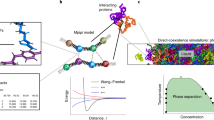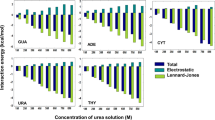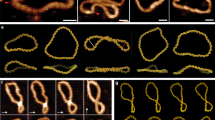Abstract
DNA MELTING studies have revealed fine structural features in the melting profiles of many natural DNAs1–4. Restriction fragments have been used to assign modes showing up in melting profiles to the denaturation of well delineated segments inside the DNA molecule1,3 and possible correlations of these segments with biological functions have been suggested1,5,6. However, when the exact sequence of natural DNAs became available, known genetic or regulatory features extending over tens to hundreds of base pairs did not appear to be characterized systematically by simple physical parameters. For example, the base pair composition fluctuation of ΦX174 DNA is almost smooth6,7, whereas several distinct modes are seen in experimental melting profiles8,9, each reflecting separate melting of segments of hundreds of base pairs. Attempts have been made to calculate the melting profiles of DNA from its sequence10–13, and two calculated melting profiles have been published for ΦX174 DNA. Both calculated curves show fine structure, but comparison with the experimental profiles showed ‘no obvious systematic relationship’ (ref. 8). The very different profiles observed for the same ΦX174 DNA in two different ionic strengths8 could not be accounted for by the theory used. Thus the melting profile is not determined by the DNA sequence alone. However, recently good agreement between the calculated and experimental melting profile of ΦX174 DNA was obtained by Azbel14–16. Azbel's model is based on the observation that nucleation of the helix–coil transition requires much higher energies than that exchanged between base pairs, so that behaviour of DNA is mainly correlated to its ground state at a given temperature inside the melting range (see ref. 16). We have applied Azbel's model to another DNA of known sequence (a restriction fragment of SV40 DNA) and ΦX174 DNA in two different environmental conditions, and we obtained good agreement between predictions and experimental observations.
This is a preview of subscription content, access via your institution
Access options
Subscribe to this journal
Receive 51 print issues and online access
$199.00 per year
only $3.90 per issue
Buy this article
- Purchase on Springer Link
- Instant access to full article PDF
Prices may be subject to local taxes which are calculated during checkout
Similar content being viewed by others
References
Reiss, C. & Gabarro-Arpa, J. Prog. mol. subcell. Biol. 5, 1–30 (1977).
Vizard, D. L. & Ansevin, A. T. Biochemistry 15, 741–750 (1976).
Michel, F. J. Molec. Biol. 89, 305–326 (1974).
Lyubchenko, Y.L., Frank-Kamenetskii, M. D., Vologodskii, A. V., Lazurkin, Y. & Gautze, G. C. Jr, Biopolymers 15, 1019–1036 (1976).
Tachibana, H., Wada, A., Gotoh, O. & Takanami, M. Biochim. biophys. Acta 517, 319–328 (1978).
Tong, B. Y. & Batterby, S. J. Biopolymers 17, 2933–2937 (1978).
Ueno, S., Tachibana, H., Husimi, Y. & Wada, A. J. Biochem. 84, 917–924, (1978).
Vizard, D. L., White, R. A. & Ansevin, A. T. Nature 275, 250–251 (1978).
Lazurkin, Y. S. Molec. Biol. 11, 1007–1017 (1978).
Tong, B. Y. & Tong, S. Y. J. chem. Phys. 54, 1317–1324 (1971).
Poland, D. Biopolymers 13, 1859–1871 (1974).
Fixman, M. & Freire, J. J. Biopolymers 16, 2693–2704 (1977).
Frank-Kamenestskii, M. D. & Frank-Kamenestskii, A. D. Molec. Biol. 3, 375–383, (1969).
Azbel, M. Y. Proc. natn. Acad. Sci. U.S.A. 76, 105, (1979).
Azbel, M. Y. Phys. Rev. Lett. 31, 589–593 (1973).
Azbel, M. Y. Ann. Isr. Phys. 2, 26–36 (1978).
Gruenwedel, D. W. Biochim. biophys. Acta 340, 16–30 (1974).
de Zamaroczy, M. thesis, Univ. Paris (1978).
Gabarro-Arpa, J. Analyt. Biochem. 91, 308–322 (1978).
Fiers, W. Nature 273, 113–120 (1978).
Sanger, F. et al. J. Molec. Biol. 125, 225–246 (1978).
Author information
Authors and Affiliations
Rights and permissions
About this article
Cite this article
GABBARRO-ARPA, J., TOUGARD, P. & REISS, C. Correlation of local stability of DNA during melting with environmental conditions. Nature 280, 515–517 (1979). https://doi.org/10.1038/280515a0
Received:
Accepted:
Published:
Issue Date:
DOI: https://doi.org/10.1038/280515a0
This article is cited by
-
Simple models of non-linearDNA dynamics
La Rivista Del Nuovo Cimento Series 3 (1994)
-
Theory agrees with experimental thermal denaturation of short DNA restriction fragments
Nature (1981)
Comments
By submitting a comment you agree to abide by our Terms and Community Guidelines. If you find something abusive or that does not comply with our terms or guidelines please flag it as inappropriate.



